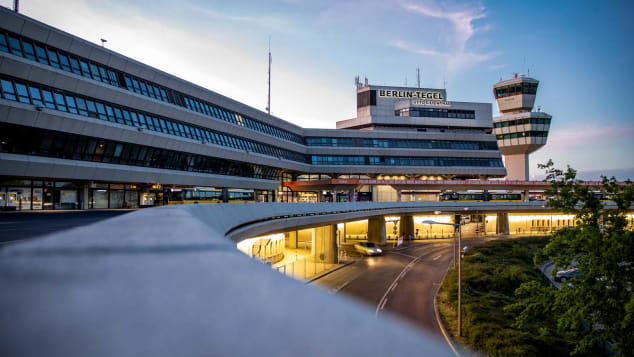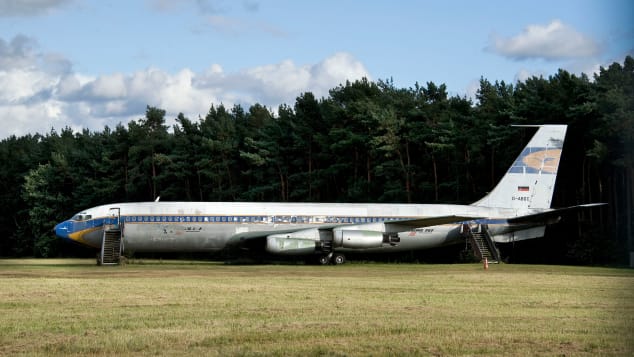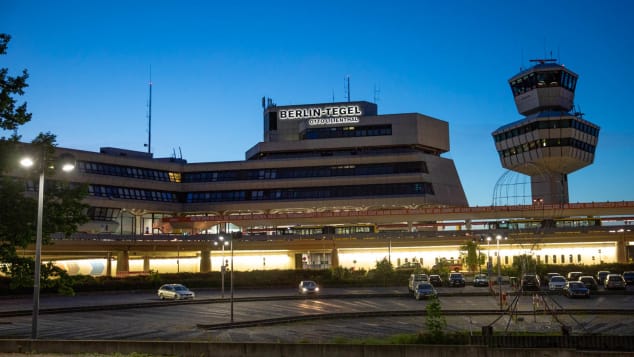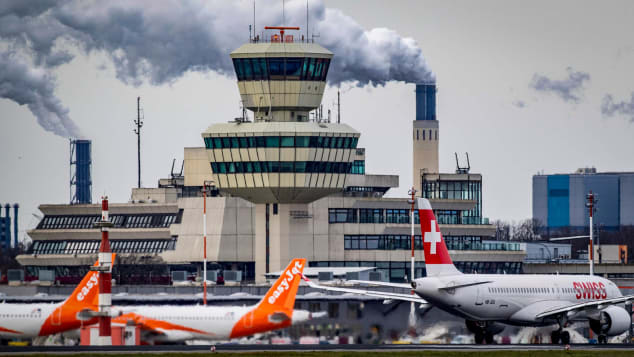While the imminent opening of Berlin's long-delayed Brandenburg Airport will cause many in the city to breathe a sigh of relief, it also means the sad end of an era.
As Brandenburg cranks into action, Berlin's Tegel Airport -- a much-loved relic from the last century -- will at long last be closing for good.
In truth, Tegel should've been decommissioned years ago. It was congested, tired and outdated. But Brandenburg's decade of delays kept it alive as a stand-in, and for all its faults, it had many admirers.
Even efforts to permanently close the airport earlier this year due to the coronavirus pandemic failed. Tegel managed to evade death one last time. Despite its relatively small size, it became Germany's fourth busiest airport and symbolized Berlin like few other public buildings.
Berlin's airports were never just means of transport, never just faceless terminals in the middle of a field. These facilities perfectly reflect the turbulent story of the city in the 20th and 21st century.
The most famous, Tempelhof, was opened in 1927, and sealed its place in aviation history during the Berlin airlift of 1948-49 when the city was blockaded by the Soviet Union.
Now closed, it's been transformed into a park and sought-after location for World War II movies. The city's other main airport, Schönefeld, opened in 1946 as the main airfield of East Germany, and retained something of that Soviet atmosphere well beyond the country's reunification.
Of all of them, it's Tegel that holds a special place in the heart of many Berliners.
Stalin's orders
Like so many other things in the city, Tegel Airport is a stopgap measure that somehow became permanent. After World War II, when West Berlin was still in the hands of allied forces, there were plans to turn the area into allotments, but Soviet leader Joseph Stalin had different plans.
As the blockade he ordered began in June 1948, it turned out quickly that there was need for an additional airfield to bring supplies in, so the French authorities in charge of the Tegel district ordered the construction of a 2,500-meter-long runway -- the longest in Europe at the time.
The first plane, a USAF Douglas C-54, landed in November 1948. After the blockade ended six months later, Tegel became the Berlin base of the French Air Force.
In the late 1950s, with increased air traffic coming into West Berlin in ever bigger planes, the runways at Tempelhof were proving too short, so over the next two decades Tegel became the main airport.
The city's special status during the Cold War meant that only the Allies could operate military and civilian aircraft from and to Tegel. All passengers had to use the airport's original small prefabricated terminal building.
Despite these cramped conditions and restrictions, for some the airport truly was a gateway to freedom. Drahomira Bukowiecki fled communist Czechoslovakia in 1968 to West Berlin and was sentenced to 10 years hard labor in absentia.
For her, the airport became the only means of escaping a city surrounded by communism."I could only ever leave through Tegel, as I would have been arrested if I tried to cross the GDR via land," Bukowiecki tells CNN Travel. "So Tegel truly became my gateway to the world, also because I took a plane for the first time in my life from here."
Hexagonal glamor

The airport continued to make an impression on Berliners, especially after a new, mildly brutalist and hexagonally shaped terminal building was opened in 1974.
The striking design shortened walking distances to as short as 30 meters from aircraft to the terminal exit."To me and many other West Berliners, Tegel really was a place apart," Bukowiecki adds. "It symbolized the glamorous world of air travel with its shops that sold wonderful things and the whole process of taking a flight which was very different in the 1970s."
And even after reunification, with air travel becoming available widely, that view did not change. Schönefeld really is so far away from the city center. So for me and my generation Tegel is the true Berlin airport, a part of us and the one place that enabled us to fly to freedom!"In the next few years things really took off for Tegel.
On September 1, 1975, Pan Am and British Airways moved their entire Berlin operation here overnight. Retired journalist Jutta Hertlein remembers the excitement of her neighbors when the new terminal started its operations.
"In the morning my neighbor came to me and asked if I had heard all the planes flying low over the house all night -- they were moving them from Tempelhof to Tegel," she says. "But I had been so immersed in my work that I did not hear a thing."
Hertlein also recalls that Tegel occupied a significant place in the political landscape of Berlin and Germany, for better or worse. "I used it often to travel for work; but at the same time in the '80s the airport was already used for the deportation of asylum seekers."
There was a large protest planned on one such occasion, and I went to join the protestors at Tegel in the morning, but as I was wearing my usual business attire the policemen cordoning off the protest tried to guide me to the airport as I did not look like a protester at all -- but I wanted to show that it's not just the young punks and leftists protesting these deportations."
With German reunification in 1990 and the government moving from Bonn to Berlin, all restrictions on Berlin air traffic were lifted and Tegel became the official German government airport.
That role has meant it's seen the US President's Air Force One landing here more often than any other airport in Germany. Reunification also meant that passenger numbers and flights increased exponentially as air travel became more and more commonplace.
Tegel was designed for handling 2.5 million passengers a year, but 24 million people flew from here in 2019. While a new third terminal was added in 2007, Tegel became increasingly cramped, with operations and facilities clearly outdated.
There was no direct public transport connection either. Travelers using Berlin's U-Bahn metro system had to change to a bus at Kurt-Schumacher-Platz. Even Schönefeld had better rail connections."Tegel's unique architecture and design make you feel like being time-warped into the 1970s," says frequent traveler Michael Stoffl, from Berlin.
"The airport is tiny, especially when compared to other major capitals around the globe." The airport may have been considered modern and appropriate when it was opened but, especially over the last decade, passengers were to experience its downsides, like often feeling crammed and chaotic -- and definitely the lack of space.
"You had to make sure you didn't line up in the wrong queue at the check-in counters as it was often confusing where each one led to.
"Many Tegel regulars rave about its proximity to the city center, which makes for a quick transfer into town -- unless you were using public transport. Personally, I won't be missing Tegel, except perhaps from a nostalgic aspect.''
But Tegel's car-friendly design endeared the airport to many, especially in the Berlin hospitality sector. Tilman Hierath is the managing partner of the Circus Hotel on Rosenthaler Platz as well as an enthusiastic hobby pilot and loves to use the airport.
"Tegel is easily the best airport in the world," he says. "And I don't only say that because I'm madly in love with its '70s ugliness."This design might not be efficient to operate, but it is a traveler's dream of short waiting times and short distances. When the cab drivers went on strike a few years back, I rented a van and drove our guests from the hotel to the airport.
"In Tegel that does not mean to an entrance two counties away. Instead, we were able to drop our guests off directly at their gate. It is the only major airport I know where you can see the check-in counter from the curb and the airplane from the check-in counter."
Shabby charm

Hierath recalls a particular incident involving a time-pressed guest. "He needed to be in a very important meeting at our hotel and also needed to catch his flight that afternoon.So our front desk actually called Tegel and they held the gate open for our guest."
It is this personal touch that made all the difference. Tegel was not designed to intimidate and impress, it was designed to be at the traveler's service."Tegel has always seemed an appropriate entrance to Berlin.
It's not a sleekly designed airport strewn with massage seats and smart screens. Instead, like the city it serves, it has a shabby charm and a good heart.
Its character shows through in the quirky parts of the airport unrelated to flight operations. At the end of the runway sits an old Boeing 707, originally operated by El Al, that was once the target on an attempt by Palestinian terrorists to hijack it in 1970.
It was decorated in vintage Lufthansa markings and presented to the airline by Boeing as a gift in 1986. As no German pilots or carriers were permitted to fly into Tegel at the time, the plane was covered with white stickers and delivered by an American crew at night, to be revealed in Lufthansa colors the next day.
The aircraft was presented by Lufthansa to West Berlin in 1987 as part of celebrations for the city's 750th birthday. Eventually it was shuffled off to a far-flung corner of the airfield, occasionally being used for evacuation training.
At the other end of Tegel is the small but quirky Allierte in Berlin museum, a private collection operated by volunteers and dedicated to the history of the Allied forces in Berlin.
Bowie and Reagan

The airport itself is due to be confined to history on November 8 when the final scheduled flight to leave Tegel will be -- fittingly -- an Air France service to Paris.
After that, the future is somewhat uncertain. Real estate developers and architects are ready to reinvent the airport: There are plans to develop the site into a so-called "Urban Tech Republic," a high tech business hub that could provide 18,000 jobs.
Tegel's A and B terminals will be used by the University of Applied Sciences Berlin to establish a new technology park for up to 2,500 students. The remaining area will be available for industrial use, the largest single inner-city development area in contemporary Berlin.
Whatever its fate, the airport's place in the story of Berlin will forever cement its status as "the" city airport, particularly, as British writer and Berlin expert Paul Sullivan points out, thanks to its role in recent pop culture.
"I think that over the decades the airport's modest dimensions and aesthetic and the fact that many celebrities like David Bowie and Ronald Reagan used it to enter West Berlin really created a lot of affection in Berliners," he says.
"Even the overpriced Currywurst stall outside the terminal, made to look like an S-Bahn carriage, to me symbolizes the airport's charming crappiness."Even though the neighbors will be relieved, the one thing that I'll miss about Tegel the most is the direct, loud and smelly experience of travel.
There was something genuinely appealing about waiting at the bus stop on Kurt-Schumacher-Platz near the kebab stands and Chinese restaurants and watching the planes roar in just 50 meters overhead on their final approach to the airport. Tegel was one of the last of a dying breed: a veteran city airport, battered and forever unbeaten.
Latest Stories
-
Volta Region movie industry stagnated, needs investors to push – stakeholders
9 minutes -
Petition against Chief Justice reflects broader public concerns about Judiciary – Joyce Bawa
11 minutes -
Northern Ghana won’t experience fuel shortage – NPA assures
26 minutes -
Calm restored in Ejura after mob attack on Police Station
30 minutes -
18-year-old herdsman remanded over murder of younger brother
31 minutes -
GSTEP 2025 Challenge: Organisers seek to support gov’t efforts to tackle youth unemployment
2 hours -
Apaak assures of efforts to avert SHS food shortages as gov’t engages CHASS, ministry on Monday
3 hours -
Invasion of state institutions: A result of mistrust in Akufo-Addo’s gov’t ?
3 hours -
Navigating Narratives: The divergent paths of Western and Ghanaian media
3 hours -
Akufo-Addo consulted Council of State; it was decided the people won’t be pardoned – Former Dep. AG
3 hours -
People want to see a president deliver to their satisfaction – Joyce Bawah
4 hours -
Presidents should have no business in pardoning people – Prof Abotsi
4 hours -
Samuel Addo Otoo pops up for Ashanti Regional Minister
4 hours -
Not every ministry needs a minister – Joyce Bawa
5 hours -
Police shouldn’t wait for President’s directive to investigate election-related deaths – Kwaku Asare
5 hours

